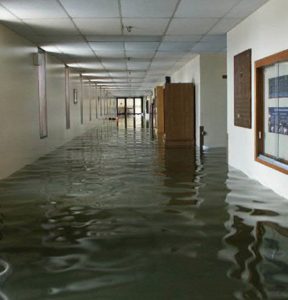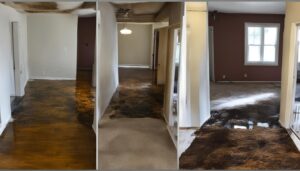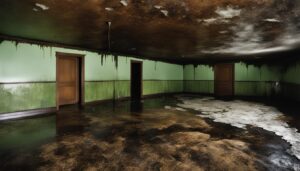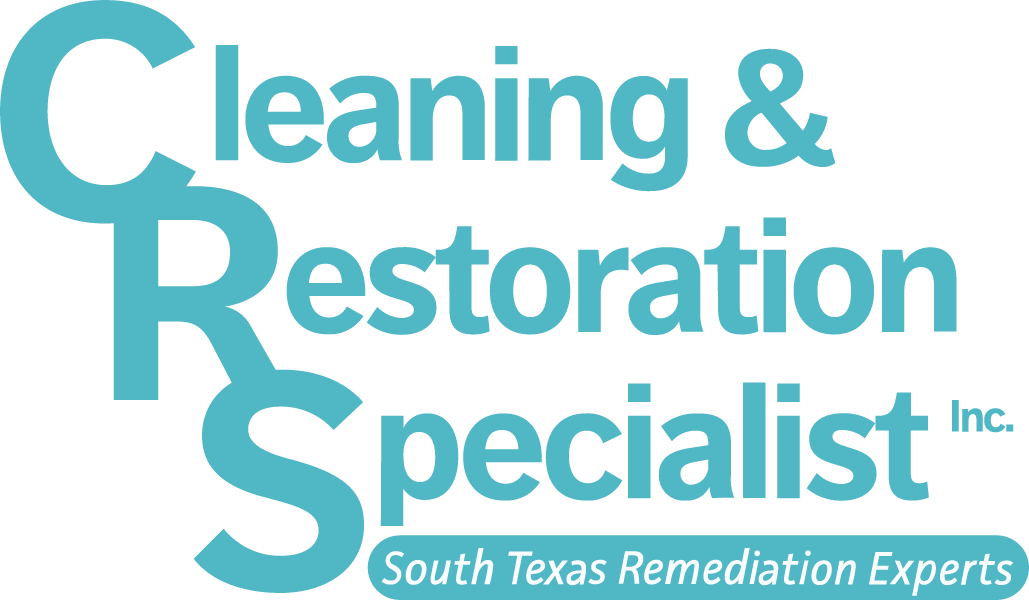If you have experienced water damage in your home or business, it’s crucial to be aware of the potential health risks associated with mold growth. Mold from water damage can pose serious health threats to you and your loved ones, and it’s essential to take preventive measures and seek professional help when necessary.
In this section, we will delve into the health risks associated with mold growth resulting from water damage. You’ll learn about the various risks and health issues that may arise from exposure to mold, particularly in the context of water damage.
Key Takeaways:
- Mold from water damage can pose serious health risks to individuals.
- It’s essential to understand what mold is and how it develops in the context of water damage.
- Exposure to mold from water damage can lead to various respiratory and allergic reactions.
- Certain populations, such as infants and the elderly, may be more vulnerable to health risks from mold exposure.
- Preventive measures and prompt action are necessary for safeguarding your health and addressing mold-related issues.
Understanding Mold and Water Damage
To effectively mitigate the impact of mold from water damage, it’s important to first understand what mold is and how it develops in such conditions. Mold is a type of fungus that thrives in moist, warm environments, and can spread and grow rapidly if gone unchecked.
Water damage is one of the primary catalysts for mold growth, as it creates an ideal setting for spores to take hold and proliferate. Once a colony has formed, it can quickly become difficult to contain, affecting not just walls and ceilings, but also furniture, carpets, and other household items.
To mitigate the impact of mold growth, it’s therefore essential to not only address any immediate water damage, but also to understand how to prevent future water intrusion and implement steps to control humidity levels in the affected area.
Tip: Keep an eye out for water damage in the form of wet spots, discoloration, or peeling paint. Address any water damage immediately to prevent the development of mold.
In addition, it’s important to understand the various types of mold that can develop in the home. From the potentially toxic Stachybotrys chartarum, to the more common Aspergillus and Penicillium, each type of mold can have a different impact on health and require different mitigation protocols.
| Type of Mold | Health Impact | Mitigation Protocol |
|---|---|---|
| Stachybotrys chartarum | Potentially toxic, can cause respiratory and neurological issues | Professional remediation may be required |
| Aspergillus | Can cause allergic reactions and respiratory issues | Surface cleaning with bleach or other disinfectants may suffice |
| Penicillium | Can cause allergic reactions and contribute to asthma | Surface cleaning with bleach or other disinfectants may suffice |
By understanding the nature of mold growth in the context of water damage and the potential health and safety risks associated, homeowners can take proactive steps to mitigate the impact, improving their quality of life and minimizing the risk of long-term health complications.
Health Issues Caused by Mold Exposure
Exposure to mold from water damage can cause a range of health issues, affecting your respiratory system and leading to allergic reactions. The symptoms may vary depending on the extent of mold exposure and individual sensitivity.
Respiratory issues are among the most common health problems resulting from mold exposure. Mold spores enter your lungs when you breathe, causing irritation, inflammation, and other respiratory problems. If you have a pre-existing respiratory condition, such as asthma, exposure to mold can exacerbate your symptoms and lead to severe complications.
Allergic reactions are another common health issue resulting from mold exposure. When you come into contact with mold spores, your immune system may react, triggering symptoms such as sneezing, runny nose, and itchy eyes. For individuals with allergies, exposure to mold can lead to more serious reactions such as hives and difficulty breathing.
In some cases, prolonged exposure to mold from water damage can result in more serious health complications. These complications may include neurological problems, memory loss, and even cancer. It’s essential to take any potential mold exposure seriously and seek appropriate medical attention if you experience any symptoms related to mold exposure.
Vulnerable Populations at Risk
While mold exposure from water damage poses a risk to everyone, certain individuals are more vulnerable to the health impacts than others.
| Population at Risk | Reason for Higher Risk |
|---|---|
| Infants and young children | Immature immune systems and inability to communicate symptoms |
| The elderly | Weakened immune systems and increased risk of respiratory issues |
| Individuals with weakened immune systems | Reduced ability to fight off infections and illnesses |
| Those with pre-existing respiratory conditions | Increased likelihood of exacerbating symptoms and developing infections |
If you or a loved one fall under any of these vulnerable populations, it’s crucial to take extra precautions and seek medical attention if you notice any symptoms of mold exposure. Protecting your health is vital for vulnerable populations.
Long-Term Health Effects of Mold Exposure
When dealing with mold from water damage, it’s important to understand the potential long-term consequences of exposure to mold. While short-term symptoms such as coughing, sneezing, and skin irritation may subside over time, repeated or prolonged exposure can lead to more serious health effects.
Some of the long-term health effects of mold exposure include:
| Health Effect | Description |
|---|---|
| Respiratory Problems | Chronic coughing, wheezing, and difficulty breathing. |
| Neurological Issues | Headaches, memory loss, and mood changes. |
| Cancer | Long-term exposure to some types of mold has been linked to an increased risk of lung cancer. |
| Immune System Suppression | Mold exposure can weaken your immune system, making it harder to fight off infections. |
If you suspect that you have been exposed to mold, it’s important to take action to protect your health. Long-term exposure to mold from water damage can have serious consequences, so it’s crucial to take steps to identify and address any mold-related issues in your living environment.
Preventing Mold Growth and Protecting Your Health
Preventing mold growth is essential to safeguarding your health and the health of your loved ones. Here are some practical tips and strategies to prevent mold growth:
- Fix any leaks: Leaks provide moisture that can promote mold growth. Make sure to fix any leaks in your home, including leaky pipes, faucets, and roofs.
- Control humidity levels: Mold thrives in humid environments. Use air conditioners and dehumidifiers to keep the humidity levels in your home below 60 percent.
- Ventilate: Make sure to use exhaust fans in the bathroom, kitchen, and laundry room to remove excess moisture from the air.
- Clean up water damage promptly: If you experience any water damage in your home, make sure to clean it up quickly and thoroughly to prevent mold growth.
- Improve air circulation: Good air circulation can help prevent mold growth. Keep furniture away from walls, open doors between rooms, and use fans to improve air flow.
- Use mold-resistant products: Consider using mold-resistant drywall, paint, and insulation in your home to reduce mold growth.
By following these tips, you can prevent mold growth and protect your health.
Recognizing and Addressing Mold-Related Issues
Having mold in your living space can be dangerous to your health. It is vital to recognize the presence of mold and take appropriate actions to address the problem.
Recognizing Mold:
| Signs Of Mold Presence | What To Do |
|---|---|
| Visible spots or streaks on your walls, ceilings, or floors |
|
| Noticeable damp or musty smell in your room |
|
| You or your loved ones experience allergic reactions or persistent respiratory symptoms |
|
Addressing mold issues require specific knowledge and skills, which is why professional assistance is highly recommended. Mold remediation may include cleaning or removal of contaminated materials, air filtration, and addressing the source of water damage.
Take prompt action to ensure your living environment is safe and healthy for you and your loved ones.
Conclusion
In conclusion, it is crucial to understand the health risks associated with mold exposure resulting from water damage. By gaining insight into the potential health implications, you can take proactive steps to prevent mold growth and protect yourself and your loved ones. Remember to take preventive measures such as fixing leaks promptly, monitoring humidity levels, and proper ventilation. If you suspect mold growth, it is important to address it promptly by seeking professional assistance to prevent further health complications. Stay informed and take the necessary precautions to ensure a healthy living environment for you and your family.
FAQ
What are the health risks associated with mold from water damage?
Mold from water damage can pose various health risks. When exposed to mold, individuals may experience respiratory issues, allergies, and other allergic reactions. Prolonged exposure can lead to more severe complications.
What is mold and how does it develop in the context of water damage?
Mold is a type of fungus that can grow in moist environments. When water damage occurs, such as leaks or floods, it creates the perfect conditions for mold growth. Mold spores can then spread and reproduce, causing further damage if not addressed promptly.
What are the health issues that can be caused by mold exposure?
Mold exposure can lead to a range of health issues, including respiratory problems such as coughing, wheezing, and shortness of breath. It can also trigger allergies, irritate the eyes, throat, and skin, and worsen existing respiratory conditions.
Who are the vulnerable populations at higher risk of mold exposure?
Certain individuals are more vulnerable to the health risks associated with mold exposure. Infants, the elderly, individuals with weakened immune systems, and those with pre-existing respiratory conditions are among the populations at higher risk.
What are the potential long-term health effects of mold exposure?
Prolonged exposure to mold from water damage can have long-term health effects. These may include chronic respiratory conditions, persistent allergies, asthma development or worsening, and even increased risk of infections.
How can I prevent mold growth and protect my health?
Taking preventive measures is essential for inhibiting mold growth and protecting your health. Ensure proper ventilation, control moisture levels, fix water leaks promptly, use dehumidifiers if necessary, and regularly clean and inspect vulnerable areas in your home.
How can I recognize and address mold-related issues in my living environment?
Being able to recognize the presence of mold is crucial for addressing any potential issues. Look out for visible signs of mold, such as discolored patches or a musty odor. If you suspect mold, it is important to take immediate action by consulting a professional mold remediation service and addressing the underlying water damage.
What should I do to ensure a healthy living environment?
Understanding the health risks associated with mold exposure resulting from water damage is important. Take proactive steps such as preventing mold growth, promptly addressing any issues, and staying informed about proper home maintenance. By doing so, you can create a healthy living environment for yourself and your loved ones.









